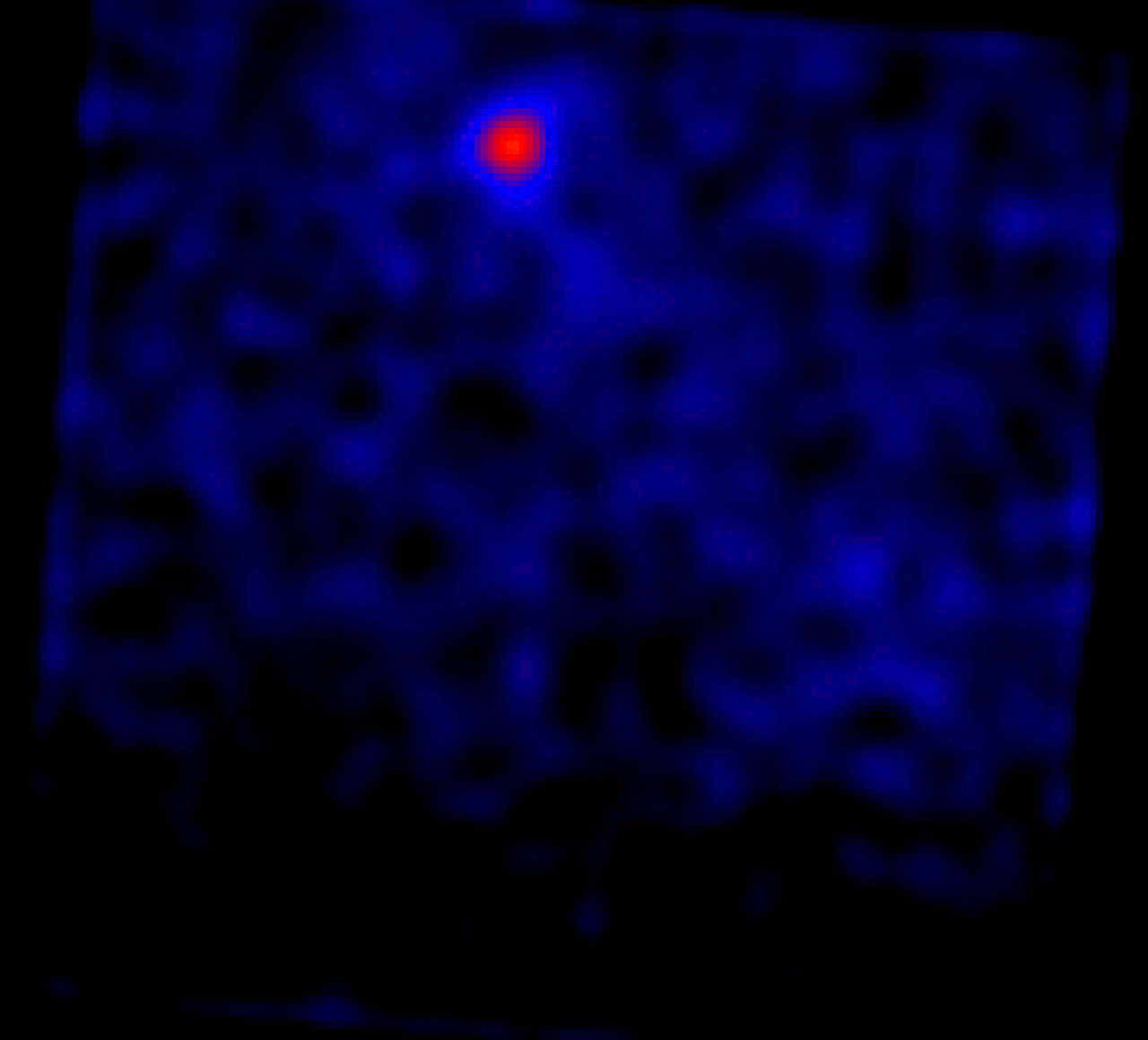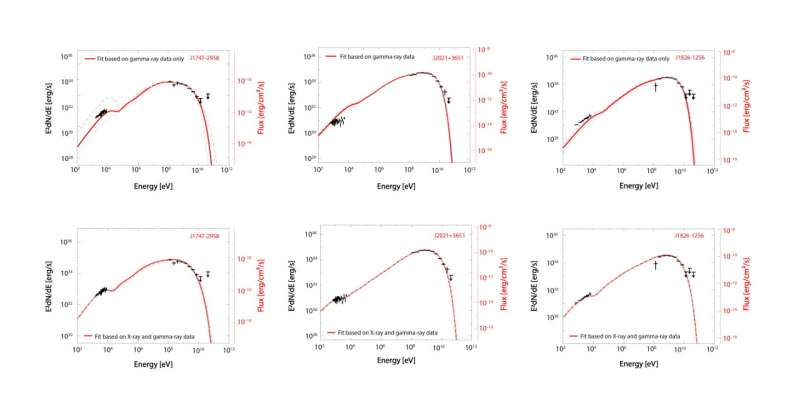From gamma rays to X-rays: New method pinpoints previously unnoticed pulsar emission

Based on a new theoretical model, a team of scientists explored the rich data archive of ESA's XMM-Newton and NASA's Chandra space observatories to find pulsating X-ray emission from three sources. The discovery, relying on previous gamma-ray observations of the pulsars, provides a novel tool to investigate the mysterious mechanisms of pulsar emission, which will be important to understand these fascinating objects and use them for space navigation in the future.
Lighthouses of the Universe, pulsars are fast-rotating neutron stars that emit beams of radiation. As pulsars rotate and the beams alternatively point towards and away from Earth, the source oscillates between brighter and dimmer states, resulting in a signal that appears to 'pulse' every few milliseconds to seconds, with a regularity rivalling even atomic clocks.
Pulsars are the incredibly dense, extremely magnetic, relics of massive stars, and are amongst the most extreme objects in the Universe. Understanding how particles behave in such a strong magnetic field is fundamental to understanding how matter and magnetic fields interact more generally.
Originally detected through their radio emission, pulsars are now known to also emit other types of radiation, though typically in smaller amounts. Some of this emission is standard thermal radiation – the type that everything with a temperature above absolute zero emits. Pulsars release thermal radiation when they accrete matter, for example from another star.
But pulsars also emit non-thermal radiation, as is often produced in the most extreme cosmic environments. In pulsars, non-thermal radiation can be created via two processes: synchrotron emission and curvature emission. Both processes involve charged particles being accelerated along magnetic field lines, causing them to radiate light that can vary in wavelength from radio waves to gamma-rays.
Non-thermal X-rays result mostly from synchrotron emission, while gamma-rays may come from so-called synchro-curvature emission – a combination of the two mechanisms. It is relatively easy to find pulsars that radiate gamma-rays – NASA's Fermi Gamma-Ray Space Telescope has detected more than 200 of them over the past decade, thanks to its ability to scan the whole sky. But only around 20 have been found to pulse in non-thermal X-rays.
"Unlike gamma-ray detecting survey instruments, X-ray telescopes must be told exactly where to point, so we need to provide them with some sort of guidance," says Diego Torres, from the Institute of Space Sciences in Barcelona, Spain.
Aware that there should be many pulsars emitting previously undetected non-thermal X-rays, Torres developed a model that combined synchrotron and curvature radiation to predict whether pulsars detected in gamma-rays could also be expected to appear in X-rays.
"Scientific models describe phenomena that can't be experienced directly," explains Torres.
"This model in particular helps explain the emission processes in pulsars and can be used to predict the X-ray emission that we should observe, based on the known gamma-ray emission."
The model describes the gamma-ray emission of pulsars detected by Fermi – specifically, the brightness observed at different wavelengths – and combines this information with three parameters that determine the pulsar emission. This allows a prediction of their brightness at other wavelengths, for instance in X-rays.

Torres partnered with a team of scientists, led by Jian Li from the Deutsches Elektronen Synchrotron in Zeuthen near Berlin, Germany, to select three known gamma-ray emitting pulsars that they expected, based on the model, to also shine brightly in X-rays. They dug into the data archives of ESA's XMM-Newton and NASA's Chandra X-ray observatories to search for evidence of non-thermal X-ray emission from each of them.
"Not only did we detect X-ray pulsations from all three of the pulsars, but we also found that the spectrum of X-rays was almost the same as predicted by the model," explains Li.
"This means that the model very accurately describes the emission processes within a pulsar."
In particular, XMM-Newton data showed clear X-ray emission from PSR J1826-1256 – a radio quiet gamma-ray pulsar with a period of 110.2 milliseconds. The spectrum of light received from this pulsar was very close to that predicted by the model. X-ray emission from the other two pulsars, which both rotate slightly more quickly, was revealed using Chandra data.
This discovery already represents a significant increase in the total number of pulsars known to emit non-thermal X-rays. The team expects that many more will be discovered over the next few years as the model can be used to work out where exactly to look for them.
Finding more X-ray pulsars is important for revealing their global properties, including population characteristics. A better understanding of pulsars is also essential for potentially taking advantage of their accurate timing signals for future space navigation endeavours.
The result is a step towards understanding the relationships between the emission by pulsars in different parts of the electromagnetic spectrum, enabling a robust way to predict the brightness of a pulsar at any given wavelength. This will help us better comprehend the interaction between particles and magnetic fields in pulsars and beyond.
"This model can make accurate predictions of pulsar X-ray emission, and it can also predict the emission at other wavelengths, for example visible and ultraviolet," Torres continues.
"In the future, we hope to find new pulsars leading to a better understanding of their global properties."
The study highlights the benefits of XMM-Newton's vast data archive to make new discoveries and showcases the impressive abilities of the mission to detect relatively dim sources. The team is also looking forward to using the next generation of X-ray space telescopes, including ESA's future Athena mission, to find even more pulsars emitting non-thermal X-rays.
"As the flagship of European X-ray astronomy, XMM-Newton is detecting more X-ray sources than any previous satellite. It is amazing to see that it is helping to solve so many cosmic mysteries," concludes Norbert Schartel, XMM-Newton Project Scientist at ESA.
More information: Jian Li et al. Theoretically Motivated Search and Detection of Non-thermal Pulsations from PSRs J1747-2958, J2021+3651, and J1826-1256, The Astrophysical Journal (2018). DOI: 10.3847/2041-8213/aae92b , arxiv.org/abs/1811.08339
Journal information: Astrophysical Journal
Provided by European Space Agency





















